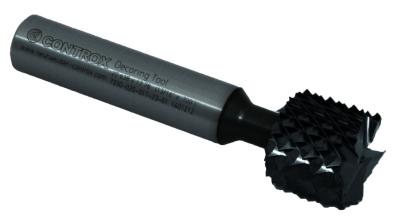
Controx-Neuhauser introduces its Decoring Cut tool, which both drills through honeycomb composite panels and undercuts the skins (thus removing the cores) in a single labor-saving step. A sophisticated end tooth design enables Decoring Cut to cut through the top skin while maintaining tight tolerances with no delamination.
After the plunging operation, the tool interpolates to undercut the skins as deep as requested by aerospace industry norms. An aggressive diamond-shaped tooth design guarantees the removal and pulverization of the material without the typical “push back” of typical tooth designs, according to the company. This saves the time required for manual core removal, tool change-out time and machining time, a significant time and cost savings, while reducing the risk of defects for manual operations.
Available in solid carbide or HSS cobalt powdered metal, Controx-Neuhäuser stocks the Decoring Cut in all industry-standard insert diameters, and in lengths so that standard 1/4”, 1/2” and 3/4” panel sizes can be accomplished in one pass. The next smaller tool can be chosen if the panel width is different. All Decoring Cut tools have a PVD multilayer coating to enhance performance and service life.
Unlike competitive coring technology, which requires a two-step process to cut through the upper skin and honeycomb section and interpolate to create a hole in the correct insert size, then remove the panel from the machine table and manually perform the undercut, the Decoring Cut is accomplished in a single setup. In addition to the high labor costs for this honeycomb removal procedure there is also an increased risk of skin defects since the precision cutting tool guidance depends on the skills of the operator. The “all in one” Decoring Cut eliminates the manual working step along with the high labor costs and the risk of defects, and reduces the high-value machining time on CNC machines.
Contact Details
Related Glossary Terms
- computer numerical control ( CNC)
computer numerical control ( CNC)
Microprocessor-based controller dedicated to a machine tool that permits the creation or modification of parts. Programmed numerical control activates the machine’s servos and spindle drives and controls the various machining operations. See DNC, direct numerical control; NC, numerical control.
- high-speed steels ( HSS)
high-speed steels ( HSS)
Available in two major types: tungsten high-speed steels (designated by letter T having tungsten as the principal alloying element) and molybdenum high-speed steels (designated by letter M having molybdenum as the principal alloying element). The type T high-speed steels containing cobalt have higher wear resistance and greater red (hot) hardness, withstanding cutting temperature up to 1,100º F (590º C). The type T steels are used to fabricate metalcutting tools (milling cutters, drills, reamers and taps), woodworking tools, various types of punches and dies, ball and roller bearings. The type M steels are used for cutting tools and various types of dies.
- physical vapor deposition ( PVD)
physical vapor deposition ( PVD)
Tool-coating process performed at low temperature (500° C), compared to chemical vapor deposition (1,000° C). Employs electric field to generate necessary heat for depositing coating on a tool’s surface. See CVD, chemical vapor deposition.
- undercut
undercut
In numerical-control applications, a cut shorter than the programmed cut resulting after a command change in direction. Also a condition in generated gear teeth when any part of the fillet curve lies inside of a line drawn tangent to the working profile at its point of juncture with the fillet. Undercut may be deliberately introduced to facilitate finishing operations, as in preshaving.
